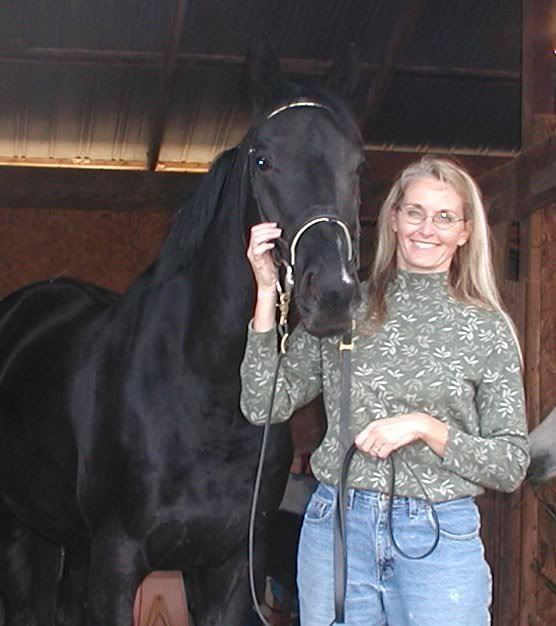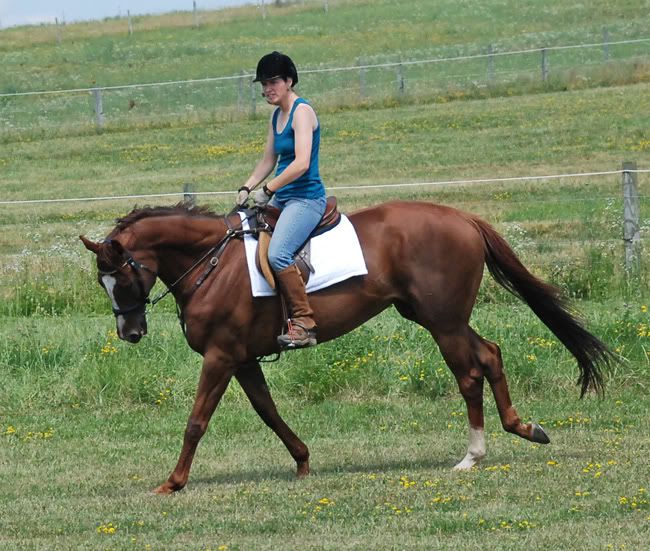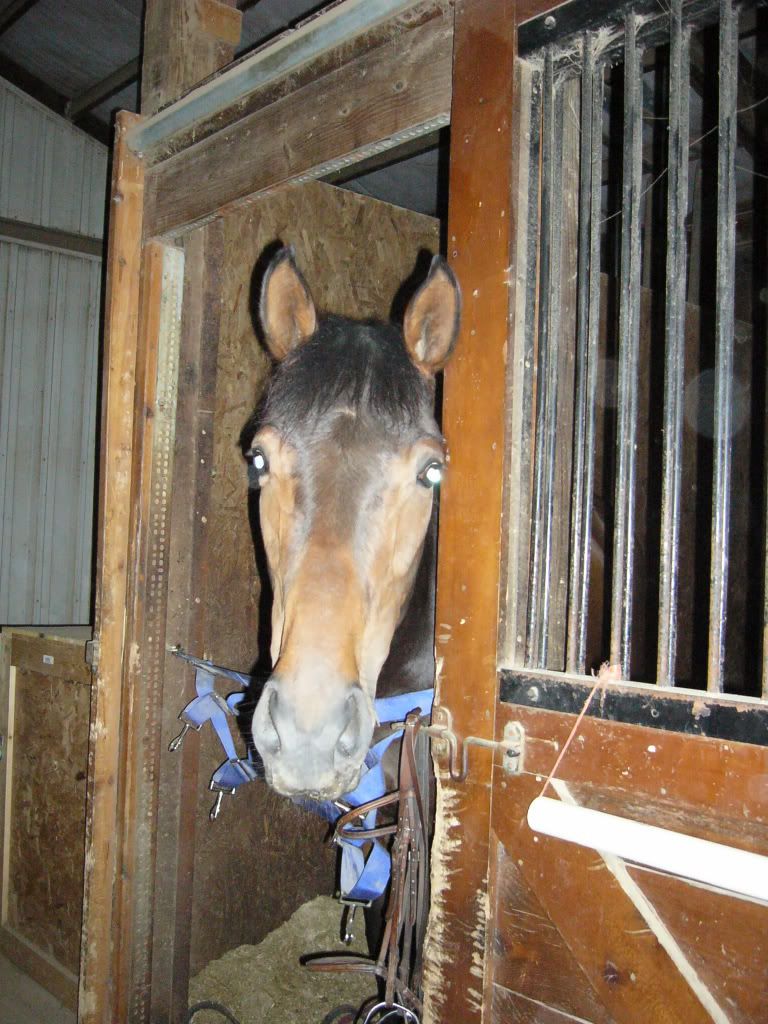|
|
Post by elevenelevenxo on Jun 14, 2009 12:20:34 GMT -5
My STB gelding has cracks in both front feet. When I got him in Feb, he was in desperate need of a trim....his feet were in awful shape. Got that taken care of. By April, he had developed a couple small cracks. My farrier said they weren't anything to worry about and when I asked if he'd recommend any topicals to put on it or something to supplement, he said no, he'd be able to trim them out at his next appointment. Next appointment came and I don't know what my farrier was thinking, but I was very unhappy with Rebel's front feet. They didn't look as if they'd been touched and the cracks were still there - a little more apparent even. We moved to a new barn and I started using the "house farrier" as my BO's horses' feet look excellent. Unfortunately, I was unable to be present for the barn call as I just started a new job and couldn't get the time off of work. My BO was there of course, so she handled it all for me. The new farrier says Rebel has "split hooves." Here are photos:  Front right  Front left. His hinds are in good shape. Farrier recommends keeping an eye on them and shoes eventually if they don't go away. Now, I'm not opposed to having him shod....if it'll help....but I'm not excited about it. An online farrier friend of mine, and someone who I have a lot of respect for, said it looked like possibly white line disease (seedy toe) to him. He recommended I dress the hooves with Tuff Stuff or buy a higher quality feed. Now, I'm currently feeding Tiz Whiz Structure, which I've heard mixed reviews on....but mainly that it's a good quality feed. Another friend of mine who worked for Last Chance Corral horse rescue here in Ohio recommended I try him on some Farrier's Formula supplement. She said they swear by it at the rescue. Can anyone offer me some advice/opinions on what you think? I need to call my vet for a sheath cleaning soon anyway...so I was going to get his advice as well, but I'm just doing what I can online until then.  Thanks! |
|
|
|
Post by Inga on Jun 17, 2009 8:54:39 GMT -5
I had a horse years ago that had these issues. I did put her on Biotin and the feet improved drastically. He hair also grew extra fast. Nice long tail to add to the benefits.
|
|
|
|
Post by Big Tee© on Jun 17, 2009 9:27:17 GMT -5
It would help also if the 'farrier' would stop rasping off the hoof wall. That leaves the structure weakened, and takes away the protective covering. With that goop all over his feet it is hard to see anything other than black and rasp marks.
What is he getting for grain? Best is plain oats and you dont need to add fancy hoof supplements, but remember, it takes almost a full YEAR to grow a new foot. If it were me, I would be doing straight oats plus vit/min supplement and maybe a couple of times a week massage something like cornucrescine into the hairline to stimulate growth - and no, more often is not better.
|
|
|
|
Post by Smay on Jun 17, 2009 12:31:14 GMT -5
Well they don't look THAT bad at the moment, but I'd like to see a view of the sole, too, to see about that seedy toe you say...
ANYWAY, looks like the farrier has put a horizontal cut across the top of that one crack, in order to "stop" it from traveling upward. That works but doesn't look too pretty. I agree with Big Tee about rasping anywhere on the wall's outer surface. that "cuts it up" and allows cracks to form on the surface.
Next time the farrier comes, also ask him/her to put a beval on the bottom rim of the hoof, or "roll" the toes a little, so there isn't as much stress on the wall as each step is placed.. His hoof will break over easier, keeping it from chipping and cracking.
And finally, you could try a supplement like Farrier's Formula - I give my one TB the double strength pellets -only an ounce a day - because he has kind of shelly feet and since his hoof grew all the way down, his feet are really 100% better. He recently held his shoes 10 weeks because of a farrier mixup... And there were no loose nails, cracks or chips anywhere.
|
|
|
|
Post by elevenelevenxo on Jun 17, 2009 13:56:54 GMT -5
Thanks for the replies.
The "goop" is just water - I had hosed him off after longeing him. I may be headed to the barn today and will snap some pics of what they look like now - about 2 weeks since those pics were taken.
I just bought some Farrier's Formula and will be starting him on that soon.
|
|
|
|
Post by Big Tee© on Jun 17, 2009 20:30:48 GMT -5
Still looks like goop!!!ROFL
Just a word of warning - that supplement will take weeks and weeks for any changes to show in his feet...his coat may look shinier within 6-8 weeks though
|
|
|
|
Post by elevenelevenxo on Jun 18, 2009 13:33:42 GMT -5
Thanks Big Tee.  I'm prepared to not see any changes for 3-6mo....at least, hopefully it'll do something in that time frame. I have a feeling he'll probably end up getting shoes on his front feet. Maybe. There's a barefoot trimmer who's basically a miracle worker and does a lot of work for the local rescues who I'll probably call to get her opinion on what would be a good route to take. She's pricey.....but I'm prepared to do what it takes. His feet were in bad shape when I got him unfortunately. So I don't think this is due to me....at least I really hope it's not. |
|
|
|
Post by jenarby on Jun 18, 2009 15:00:29 GMT -5
I'm going through this right now with three horses who came up from Florida. We've been working with two farriers and our vet. If you horse has seddy toe you have to have all the affected hoof cut out. It has to be cut back to beyond where the dead hood has stopped and you do usually get blood. If it is a big "V" cut out you horse may even need a bar show for support. Seedy toe or white line disease thrives on wet conditions as well. So you need to keep his feet dry, dry, dry. Brushing out the cut out area and never hosing it or riding in wet areas until it has healed. We had great luck so far soaking for two days in "White LIghtening/white vinegar mix" for 40 minutes each day in a plastic bag that was sealed. Then it's just keepig it dry and clean.
If your farrier doesn't cut away the hoof to above where the disease starts, you'll never get rid of it. We also took films of each horse's feet to be sure there were no pockets of dead tissue further up under the wall.
Their feet do look ugly for a while but this is really the only way to cure it.
|
|
|
|
Post by Lisann on Jun 18, 2009 15:53:12 GMT -5
soaking for two days in "White LIghtening/white vinegar mix" You're soaking in whiskey? |
|
|
|
Post by jenarby on Jun 18, 2009 21:21:23 GMT -5
lol....no it's something made for killing off the seedy toe. I had never heard of it until I saw the bottle.
Once you mix it you are supposed to seal the bag to keep the vapors in. It kind of steams inside the bag and gets into all the cracks of the hoof.
We used a thick plastic bag that SMB boots come in and soaked cotton balls in the solution, placed them in the V where the hoof was cut out and then put the bag on.....wrapped a folded hand towel around the top and duct tape. Sounds like a pain but since we only had to do it for 2 days it wans't a big deal. Now we keep the area dry and wait for it to grow out.
|
|
|
|
Post by elevenelevenxo on Jun 18, 2009 21:32:22 GMT -5
My actual farrier simply said he has "split hooves" and to keep an eye on it. If it worsens, he recommends having him shod on the fronts.
An online farrier friend of mine saw these pics and suggested it could be seedy toe or white line disease (are they one in the same?). So I don't know for sure that he does have this....but I do plan to get my vet involved.
|
|
|
|
Post by jenarby on Jun 18, 2009 21:37:15 GMT -5
My vet referred to ours as both....so I guess white line and seedy toe are the same.
|
|
|
|
Post by sophiesalibi on Jun 19, 2009 10:56:51 GMT -5
Just want to second Jen's opinion about White Lightening. It's a miracle treatment. My TB had white line disease very bad on his FL -- we kept cutting it out, cutting it out, etc. etc. It went on for what felt like forever... my farrier and I tried everything. I finally found out about White Lightening and ordered it online from Kentucky (I'm in MA). Like Jen said, you mix it with vinegar and create a gas that envelops the hoof and foot. It worked! Amazing stuff. It does bleach anything it touches so be careful, though! good luck.
|
|
|
|
Post by sarafina on Jul 2, 2009 12:55:37 GMT -5
I'm with Big Tee on the oats. It took me a long time to agree to straight "racehorse oats" with a little corn oil in them. But you should see the filly now. She looks like a quarter horse. And the gloss on her coat is really great. Still barefoot at 7. No supplements. Reminds me. I should post some new shots of the piglet.
I also think stomping flies can speed up some chipping - you might want to try those fly boots for the front legs, if he'll cope with them.
|
|
|
|
Post by elevenelevenxo on Aug 1, 2009 15:43:44 GMT -5
This is a while after I originally posted about this, but our problem is resolved it would seem. My farrier came back out and said he didn't think there was any white line or really anything to worry about. His words were, "You see it and you panic, but I see it and think it's not bad at all compared to other horses I've seen." He gave him a trim, put shoes on his fronts, and put epoxy in the cracks. Rebel's feet look fantastic now and he's a lot more comfortable in the shoes. He moves better for me and just appears happier.
We have a couple more weeks until he's due for another appointment....and for now, we're playing it by ear to see how things pan out. I may decide to keep him shod (fronts only) during the warmer months and having him go barefoot during the winter...especially if he appears to be more comfortable with shoes. Not that he was lame before - but I definitely do notice a difference in his demeanor and his way of going.
|
|















